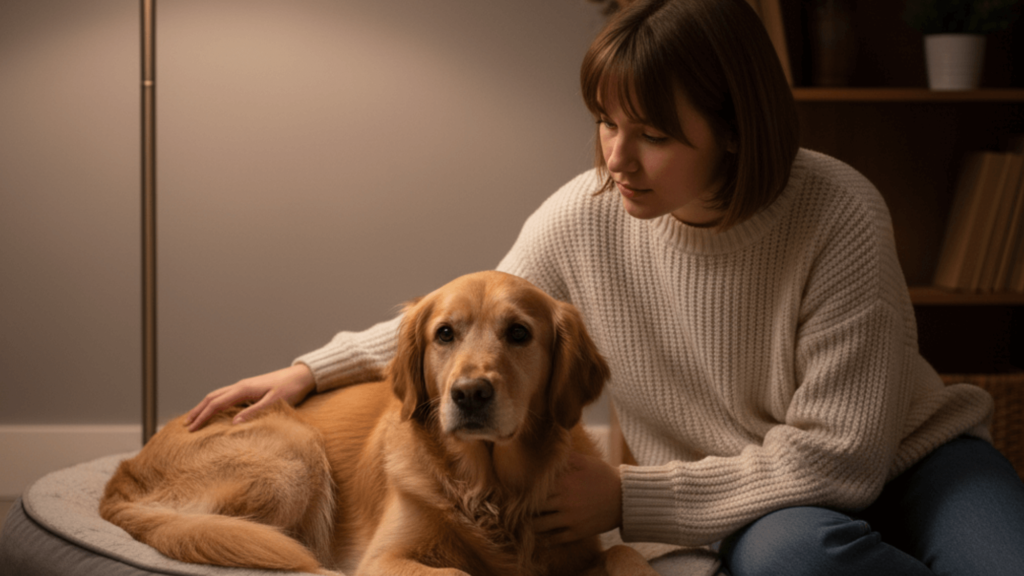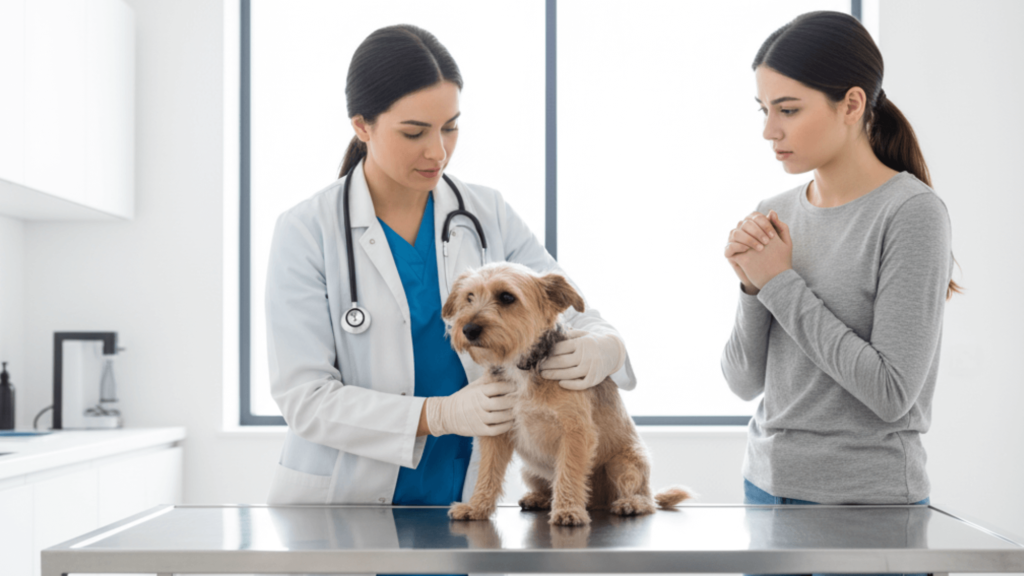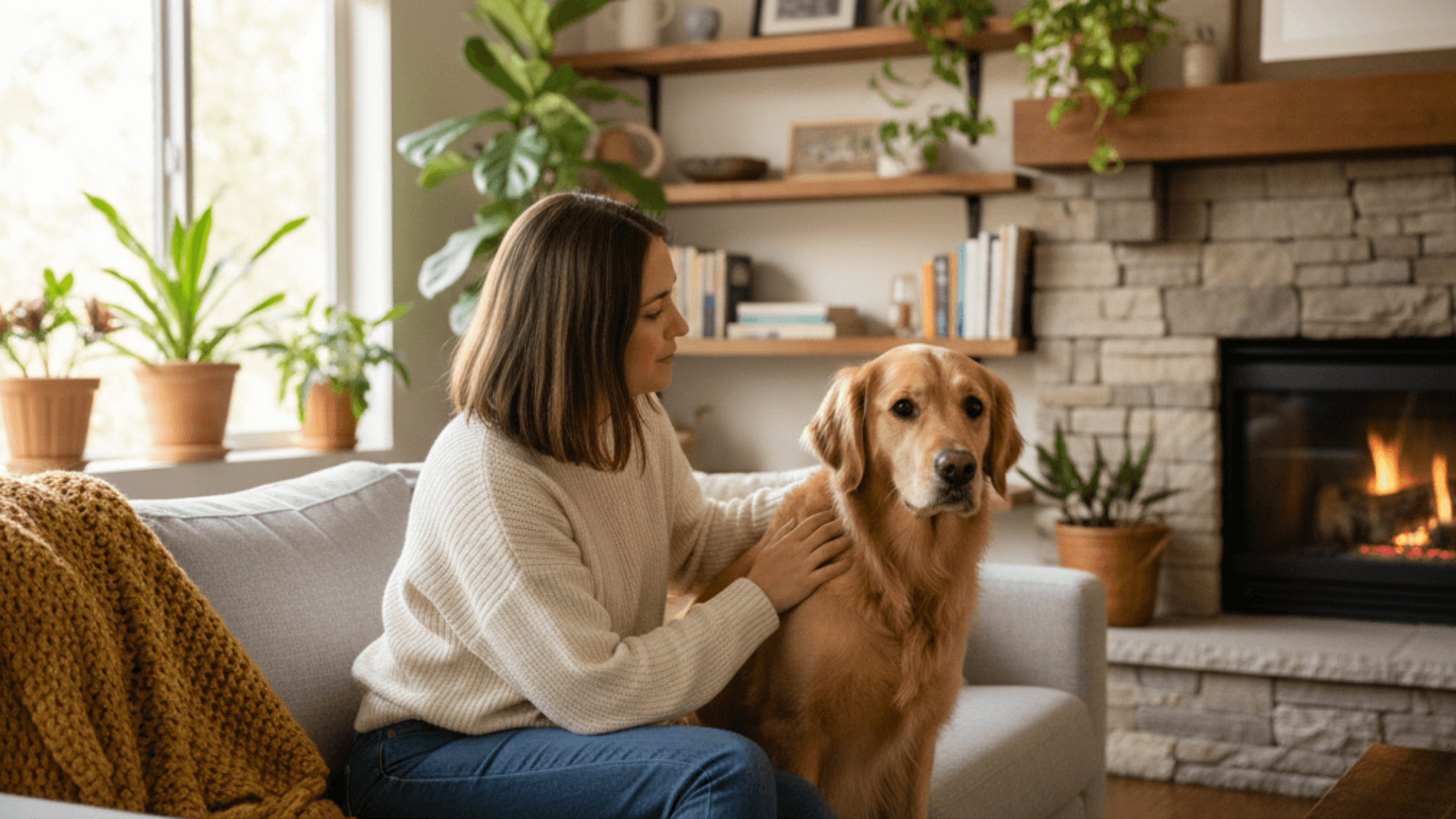5 Signs Your Dog Is Stressed (and How to Help)
Dogs may be our best friends, but they can’t tell us when they’re feeling anxious or overwhelmed. Just like humans, dogs experience stress, and it often shows through subtle changes in their behavior and body language. Recognizing the signs your dog is stressed is essential for keeping your furry friend happy, healthy, and safe. From excessive panting and hiding to unusual chewing or attention-seeking behaviors, stress can affect every aspect of a dog’s life — and ignoring it can lead to more serious health or behavioral problems.
In this post, we’ll explore 5 clear signs your dog is stressed and provide practical tips on how to help. By understanding your dog’s signals, you can reduce anxiety, strengthen your bond, and ensure your pet feels secure in any situation.

Excessive Panting, Drooling, or Shaking
Panting as a Stress Signal vs. Normal Panting
Panting is a natural behavior in dogs—it’s their primary way to regulate body temperature and cool down. After a brisk walk or play session, panting is completely normal and healthy. However, when panting occurs without a clear physical trigger, it could be a sign that your dog is stressed or anxious.
How to tell the difference:
- Context Matters: Normal panting usually follows exercise, heat, or excitement. Stress panting often happens in calm settings, during thunderstorms, vet visits, car rides, or when strangers are around.
- Body Language Clues: Stress panting is often accompanied by other signs of anxiety — ears pinned back, tail tucked, yawning, pacing, or trembling. Normal panting is usually relaxed, with no tense body posture.
- Duration and Intensity: A stressed dog may pant heavily for long periods, even after the stressor has passed, whereas normal panting subsides once your dog has cooled down or rested.
- Additional Signs: Look for other stress indicators like drooling, whining, or restlessness. If panting occurs alongside these behaviors, it’s likely stress-related.
How to help:
- Give your dog a quiet, safe space to calm down.
- Avoid forcing interaction; let them approach you when ready.
- Provide comfort with gentle petting or calming products like a Thundershirt or stress-relief treats.
By learning to distinguish between stress panting and normal panting, you can better respond to your dog’s needs and prevent prolonged anxiety or health issues.
Drooling or Licking Excessively When Anxious
While some drooling and licking is normal for dogs — especially around mealtime or after drinking water — excessive drooling or repeated licking can be a clear sign of stress or anxiety. Dogs often use licking as a self-soothing behavior, similar to how humans might fidget or pace when nervous.
How to tell it’s stress-related:
- Contextual Clues: If your dog starts drooling or licking excessively during situations that trigger anxiety — such as car rides, vet visits, loud noises, or unfamiliar environments — it’s likely a stress response rather than a normal behavior.
- Body Language Indicators: Stress-related licking is often accompanied by other anxious behaviors, such as trembling, yawning, avoiding eye contact, or a tucked tail.
- Frequency and Intensity: Normal licking or drooling is occasional, but stress-induced behaviors tend to be repetitive and persistent, sometimes directed at their own body, paws, or objects around them.
- Other Physical Signs: Some stressed dogs may also pant, pace, or whine while drooling, which reinforces the need to interpret these behaviors as anxiety signals.
How to help your dog:
- Provide a calm and safe environment where your dog can relax.
- Distract them with interactive toys, chew items, or puzzle feeders to redirect their attention.
- Use gentle reassurance — soft petting or speaking in a calm voice — but avoid overwhelming them.
- Consider products designed for anxiety relief, such as calming treats, pheromone diffusers, or a Thundershirt.
Recognizing excessive drooling and licking as a stress signal allows you to intervene early, helping your dog feel more comfortable and reducing the likelihood of developing more serious anxiety-related behaviors.
Shaking, trembling, or restlessness
Shaking, trembling, or restless movement in dogs can often be misunderstood as normal behavior, but when it occurs without an obvious cause — like cold weather or excitement — it may indicate stress or anxiety. Dogs express their emotions primarily through body language, and these behaviors are key signals that something is making them uncomfortable or nervous.
How to recognize stress-related shaking or restlessness:
- Context is Key: Observe when your dog is shaking or pacing. If it happens during thunderstorms, fireworks, trips to the vet, or around strangers, it’s likely stress-induced rather than normal physical tremors.
- Body Language Clues: Stressed dogs often have a tense body, lowered ears, tail tucked, or may pace back and forth. Their movements may seem repetitive or aimless, signaling nervous energy.
- Duration and Frequency: Normal shaking or movement is brief and situational, while stress-related trembling or restlessness can last for extended periods and may continue even after the stressful event has ended.
- Associated Symptoms: Dogs that are anxious may also whine, bark excessively, lick themselves, or show other stress behaviors along with shaking or pacing.
How to help your dog:
- Create a safe and quiet environment where your dog can calm down.
- Engage them in mental stimulation or gentle exercise to release pent-up nervous energy.
- Use calming products such as anxiety wraps, pheromone diffusers, or stress-relief treats if needed.
- Avoid scolding or forcing your dog to stay still, as this can increase anxiety.
By paying close attention to shaking, trembling, or restlessness, you can detect stress early and respond appropriately, ensuring your dog feels secure and supported in challenging situations.
How to Calm Your Dog: Gentle Petting, Safe Space
When a dog is showing signs of stress — like excessive panting, drooling, or shaking — one of the most effective ways to help them is by creating a safe, comforting environment and using gentle, reassuring interaction. Dogs rely on subtle cues from their owners, and the right approach can significantly reduce anxiety.
Gentle Petting:
- Timing and Technique Matter: Approach your dog calmly, using slow, soft strokes rather than quick or forceful pats. Focus on areas they enjoy, such as behind the ears, along the chest, or on the shoulders.
- Read Your Dog’s Signals: Pay attention to body language. If your dog leans into your touch, closes their eyes, or exhales deeply, it’s a sign they are comforted. If they pull away or show tension, give them space.
- Consistency Helps: Calm, gentle interaction over time reinforces trust and makes your dog feel secure during stressful situations.
Creating a Safe Space:
- Choose a Quiet Area: Select a spot in your home where your dog feels secure — it could be a crate, a corner with their bed, or a quiet room away from noise and distractions.
- Add Comfort Items: Include familiar blankets, toys, or clothing with your scent to make the space more soothing.
- Limit External Stressors: Close windows to block loud noises, dim lights if needed, and maintain a calm atmosphere.
- Encourage Independence: Let your dog enter the safe space voluntarily. Forcing them can increase anxiety, while voluntary retreat helps them feel in control.
Extra Tips:
- Pair gentle petting and a safe space with calming techniques, such as slow breathing near your dog or soft, reassuring verbal cues.
- Consider stress-relief products like pheromone diffusers, anxiety wraps, or calming treats to further reduce tension.
By combining gentle petting with a designated safe space, you provide your dog both physical reassurance and a sense of security, helping them recover from stress faster and feel more relaxed in future situations.
Changes in Appetite or Eating Habits
Loss of Appetite Due to Stress
A sudden decrease in appetite is one of the most common signs that a dog is experiencing stress or anxiety. Just like humans, dogs’ digestive systems are sensitive to their emotional state, and stressful situations can cause them to refuse food or eat less than usual.
How to recognize stress-related loss of appetite:
- Sudden Change: If your dog suddenly stops eating or shows less interest in meals they normally enjoy, it could be a stress response rather than a medical issue.
- Associated Behavior: Look for other signs of anxiety occurring at the same time — panting, pacing, trembling, hiding, or excessive licking.
- Context Matters: Stress-related appetite loss often happens during changes in environment, loud noises, vet visits, new pets, or separation from family members.
How to help your dog regain appetite:
- Maintain a Routine: Dogs thrive on consistency. Feeding at regular times can provide a sense of security and encourage eating.
- Make Meals Appealing: Warm up food slightly, add a small amount of low-sodium broth, or offer favorite treats to stimulate interest.
- Reduce Stressors: Provide a quiet, calm eating area free from distractions or sudden noises.
- Positive Reinforcement: Encourage eating with gentle praise, but avoid forcing food, as this can increase anxiety.
- Consult Your Vet: If loss of appetite persists for more than 24–48 hours, a veterinarian can rule out health issues and provide guidance on managing stress-related eating problems.
Understanding that loss of appetite can be a stress signal allows you to intervene early, ensuring your dog stays healthy while addressing the underlying anxiety.
Overeating as a Coping Mechanism
While some dogs lose their appetite when stressed, others may turn to food as a way to cope with anxiety. Overeating, also called stress-induced eating, is a way for dogs to self-soothe, similar to how humans might snack when feeling nervous or upset.
How to recognize stress-related overeating:
- Behavioral Clues: Your dog may eat quickly, beg for extra food, or try to scavenge for snacks even after a full meal. This is different from normal hunger cues.
- Context Matters: Overeating often occurs during stressful situations such as thunderstorms, vet visits, long periods alone, or changes in household routines.
- Accompanying Signs: Look for other stress indicators, like pacing, whining, licking, or destructive behavior — overeating rarely occurs in isolation when stress is the cause.
How to help your dog manage stress-related overeating:
- Structured Feeding Schedule: Feed at consistent times each day rather than leaving food out all the time. Measured portions help prevent overeating.
- Provide Mental Stimulation: Stress-related eating often stems from boredom or nervous energy. Interactive toys, puzzle feeders, or training sessions can redirect focus from food to positive activities.
- Exercise: Regular walks and playtime reduce anxiety and help regulate appetite.
- Stress Management Techniques: Calm environments, soothing routines, and anxiety-reducing products (like pheromone diffusers or calming treats) can lower the urge to overeat.
- Monitor Health: Chronic overeating can lead to obesity and digestive issues, so consult your vet if stress-related eating persists.
Recognizing overeating as a coping mechanism allows you to address both the emotional and physical health of your dog, helping them develop healthier ways to manage stress.
How Stress Affects Digestion
Stress doesn’t just change a dog’s appetite — it can also directly impact the digestive system, leading to discomfort and potential health problems. When a dog is anxious or nervous, their body releases stress hormones such as cortisol, which can interfere with normal digestive processes.
Signs of stress-related digestive issues:
- Upset Stomach: Stress can cause nausea, vomiting, or excessive drooling, making dogs reluctant to eat.
- Diarrhea or Soft Stools: Anxiety may speed up intestinal activity, resulting in diarrhea or inconsistent bowel movements.
- Constipation: In some cases, stress can slow down digestion, leading to constipation.
- Gas or Bloating: Changes in eating habits due to stress, like eating too quickly, may contribute to bloating or gas.
How to support your dog’s digestion during stressful times:
- Maintain a Consistent Diet: Sudden changes in food can worsen digestive issues. Stick to familiar, high-quality meals.
- Feed Smaller, Frequent Meals: Dividing daily food into smaller portions can reduce stress on the digestive system and encourage regular eating.
- Provide a Calm Eating Environment: Quiet, low-stimulation areas help your dog feel safe while eating, which supports digestion.
- Monitor Symptoms: Persistent vomiting, diarrhea, or changes in appetite may indicate severe stress or an underlying health issue — consult your veterinarian promptly.
- Stress Reduction: Implement calming techniques like gentle petting, mental stimulation, exercise, or anxiety-reducing products to improve overall digestive health.
Understanding how stress affects digestion helps dog owners take proactive steps to protect both their pet’s emotional well-being and physical health, ensuring that stress doesn’t lead to chronic digestive problems.
Tips: Feeding Routines, Stress-Relief Toys, or Calming Treats
Helping a stressed dog manage changes in appetite or anxiety-related eating behaviors requires a combination of structure, engagement, and soothing support. Here are some practical strategies:
1. Establish Consistent Feeding Routines:
- Dogs feel more secure with predictable schedules. Feed them at the same times each day to reduce anxiety around mealtime.
- Avoid leaving food out all day, which can encourage overeating or grazing out of stress rather than hunger.
- Measured portions not only control weight but also create a sense of stability.
2. Use Stress-Relief or Interactive Toys:
- Toys like puzzle feeders, treat-dispensing balls, or chew toys can engage your dog mentally and physically.
- Keeping your dog busy distracts them from anxiety-related behaviors, including overeating or refusing food.
- Mental stimulation also helps release pent-up nervous energy, reducing overall stress levels.
3. Offer Calming Treats:
- There are specially formulated calming treats that contain natural ingredients like chamomile, L-theanine, or CBD (where legal) to help soothe anxious dogs.
- Use these treats during stressful events, such as thunderstorms, vet visits, or car rides.
- Combining calming treats with positive reinforcement can create a positive association with previously stressful situations.
Extra Tips:
- Pair feeding routines with a quiet, calm environment to reduce distractions and stress.
- Rotate toys or treats occasionally to maintain interest and engagement.
- Always monitor your dog’s reaction — not every dog responds the same way to toys or calming products, so adjust based on what works best.
By implementing structured feeding routines, engaging toys, and calming treats, you can help your dog feel more secure, reduce stress-induced eating issues, and improve overall well-being.
Avoidance or Hiding Behavior
Tail Tucked, Ears Back, Cowering Signs
One of the most visible signs of stress in dogs is a change in body posture and facial expressions. Dogs communicate their emotions primarily through body language, and when they feel threatened, nervous, or overwhelmed, certain physical cues become apparent.
Key signs of stress to watch for:
- Tail Tucked: A tail held low or tucked tightly between the legs is a universal sign of fear or anxiety in dogs. It signals submission or an attempt to make themselves appear smaller in stressful situations.
- Ears Pinned Back: When a dog’s ears are flattened against their head, it often indicates discomfort or nervousness. Unlike alert or playful ear positions, pinned-back ears suggest the dog is anxious or anticipating something unpleasant.
- Cowering or Lowered Body Posture: Cowering, crouching, or lowering the body close to the ground shows that the dog is trying to protect itself or avoid confrontation. This posture may be accompanied by shivering, trembling, or avoiding eye contact.
- Associated Behaviors: Dogs exhibiting these signs may also whine, growl softly, or retreat to a corner, under furniture, or into a crate. These are all ways dogs cope with overwhelming stimuli.
How to help your dog:
- Provide a Safe Space: Encourage your dog to retreat to a quiet, comfortable area where they feel secure. Avoid forcing interaction, as this may escalate stress.
- Stay Calm and Reassuring: Speak softly and move slowly around your dog. Sudden movements or loud tones can increase anxiety.
- Observe and Respect Boundaries: Let your dog approach you on their own terms. Offering a familiar blanket or favorite toy can help them feel more comfortable.
- Gradual Exposure: For recurring stressors (like new people or loud noises), slowly introduce the dog to these situations in a controlled and positive way, rewarding calm behavior.
Recognizing tail tucking, pinned ears, and cowering as stress signals helps owners intervene early, offering comfort and reducing the risk of prolonged anxiety or fear-based behaviors.
Seeking Hiding Spots in the House
When dogs feel stressed, anxious, or overwhelmed, one of the most common coping mechanisms is retreating to a hidden or secluded spot in the home. Hiding provides them with a sense of safety and control over their environment, allowing them to calm down without direct interaction.
How to recognize hiding behavior due to stress:
- Unusual Locations: Dogs may retreat under beds, behind furniture, inside closets, or in corners where they feel protected. If your dog is frequently choosing new hiding spots, it could indicate anxiety.
- Timing: Stress-induced hiding often occurs during loud noises (like fireworks or thunderstorms), after visitors arrive, or during situations that trigger fear, such as trips to the vet.
- Body Language: While hiding, dogs often display tense muscles, lowered posture, tucked tail, and pinned-back ears, signaling continued stress even in their safe space.
- Behavioral Changes: Some dogs may also refuse interaction, whine softly, or pace while in hiding, showing that retreating is a coping mechanism rather than play.
How to help your dog:
- Create Accessible Safe Zones: Provide designated safe spaces like a crate, cozy bed, or quiet room where your dog can retreat voluntarily. Include familiar items such as blankets, toys, or clothing with your scent.
- Avoid Forcing Interaction: Let your dog come out on their own terms. Pulling them out of their hiding spot can increase anxiety.
- Positive Reinforcement: Encourage calm behavior by rewarding your dog when they leave the hiding spot voluntarily or engage in relaxed activity.
- Reduce Stress Triggers: Identify and minimize the sources of anxiety where possible, such as loud noises, crowded rooms, or unfamiliar visitors.
By observing hiding behavior and responding appropriately, you give your dog a safe outlet to manage stress, which strengthens trust and helps prevent long-term anxiety-related problems.
Separation Anxiety Triggers
Many dogs experience stress when left alone, a condition commonly known as separation anxiety. This type of anxiety occurs when dogs become overly attached to their owners and feel insecure or threatened during periods of separation. Recognizing the triggers of this stress can help prevent or reduce anxiety-related behaviors.
Common separation anxiety triggers:
- Owner Departures: Even routine departures, like leaving for work or stepping out for errands, can trigger anxiety. Dogs may sense cues such as picking up keys or putting on shoes, which signal you are about to leave.
- Changes in Routine: Alterations in daily schedules, moving to a new home, or changes in family dynamics can heighten anxiety and stress.
- Extended Alone Time: Dogs that are left alone for long periods without interaction, stimulation, or access to a safe space are more likely to develop stress-related behaviors.
- Past Negative Experiences: Previous traumatic events, such as abandonment or extended periods of isolation, can make a dog more sensitive to separation triggers.
Signs your dog is stressed by separation:
- Excessive barking, whining, or howling when you leave
- Destructive behavior, such as chewing furniture or scratching doors
- Attempts to escape or find you
- Excessive drooling, pacing, or urinating indoors
How to help:
- Gradual Desensitization: Practice short departures and slowly increase the time you’re away, rewarding calm behavior when you return.
- Safe and Comfortable Space: Provide a cozy area with toys, bedding, and items carrying your scent to make alone time less stressful.
- Interactive Toys and Puzzle Feeders: Keep your dog mentally engaged while you’re gone, reducing boredom and anxiety.
- Professional Guidance: In severe cases, consult a veterinarian or certified animal behaviorist for tailored strategies, including behavioral therapy or calming aids.
By understanding and addressing separation anxiety triggers, you can help your dog feel more secure when alone, reducing stress-related hiding behaviors and improving overall well-being.

How to Help: Safe Spaces, Positive Reinforcement, Gradual Exposure
Dogs often hide or avoid situations when they feel stressed, but with the right approach, you can help them feel safe, secure, and more confident. Combining safe spaces, positive reinforcement, and gradual exposure is one of the most effective ways to reduce anxiety and promote calm behavior.
1. Safe Spaces:
- Provide a dedicated area in your home where your dog can retreat when feeling overwhelmed. This could be a crate, a quiet room, or a cozy corner with their bed and favorite toys.
- Include familiar items with comforting scents, such as blankets or clothing with your smell, to help your dog feel secure.
- Make the space inviting and stress-free — avoid placing it in high-traffic or noisy areas.
2. Positive Reinforcement:
- Reward calm and relaxed behavior using treats, praise, or gentle petting. For example, when your dog voluntarily leaves a hiding spot or remains calm during a stressful situation, immediately acknowledge it with a reward.
- Avoid scolding or forcing your dog out of hiding, as this can increase fear and stress. Positive reinforcement strengthens confidence and encourages repeat calm behavior.
3. Gradual Exposure:
- Slowly introduce your dog to situations that trigger stress in a controlled and safe manner. Start with low-intensity exposure and gradually increase difficulty.
- Pair exposure with positive experiences, like treats, toys, or praise, to create a positive association with previously stressful situations.
- Examples include practicing short separations, introducing new people in a calm way, or playing recordings of mild sounds before louder ones.
Extra Tips:
- Be patient — anxiety behaviors take time to improve. Consistency and gentle guidance are key.
- Monitor body language to ensure your dog isn’t becoming overwhelmed during exposure exercises.
- Consider using calming products, like pheromone diffusers, anxiety wraps, or stress-relief treats, to support the process.
By combining safe spaces, positive reinforcement, and gradual exposure, you help your dog develop coping strategies for stress, reduce hiding behaviors, and build confidence in previously anxiety-inducing situations.
Destructive or Unusual Behaviors
Chewing Furniture, Scratching Doors, or Digging
Destructive behaviors like chewing furniture, scratching doors, or digging are often more than just signs of boredom—they can indicate that a dog is experiencing stress, anxiety, or nervous energy. Dogs naturally explore the world with their mouths and paws, but when these actions become excessive or occur in inappropriate places, stress may be the underlying cause.
How to identify stress-related destructive behavior:
- Contextual Triggers: Dogs often display destructive behaviors during situations that make them anxious, such as being left alone, hearing loud noises, or experiencing sudden changes in the home environment.
- Patterns and Frequency: Occasional chewing or digging is normal, but repeated or obsessive behavior—especially in combination with other stress signs like pacing, whining, or panting—suggests anxiety.
- Body Language Indicators: Stressed dogs may show a tense posture, tucked tail, pinned-back ears, or excessive licking, signaling that destructive behavior is a coping mechanism.
- Timing: Destructive behaviors often occur right before, during, or after a stressful event, such as owner departures, thunderstorms, or visits to unfamiliar places.
How to help your dog:
- Provide Adequate Physical and Mental Exercise: Daily walks, interactive play, and puzzle toys help release excess energy and reduce stress-induced destruction.
- Redirect Behavior: Offer safe alternatives like chew toys or digging pits to satisfy natural instincts in a controlled manner.
- Create a Safe Space: Encourage your dog to retreat to a calm environment when feeling anxious, reducing the urge to chew or dig.
- Positive Reinforcement: Reward calm and appropriate behavior instead of punishing destructive acts, which can increase anxiety.
- Calming Aids: Consider pheromone diffusers, anxiety wraps, or calming treats to help reduce stress levels.
- Professional Guidance: For severe or chronic destructive behavior, consult a veterinarian or animal behaviorist to develop a personalized plan.
By recognizing that chewing, scratching, and digging can be stress signals, you can address the underlying anxiety rather than simply correcting the behavior, promoting a happier and healthier dog.
Barking or Whining Excessively
Excessive barking or whining is a common sign that a dog is feeling stressed, anxious, or overwhelmed. While dogs naturally vocalize to communicate, prolonged or intense vocalization — especially in situations that wouldn’t normally trigger noise — often indicates emotional distress rather than normal behavior.
How to recognize stress-related barking or whining:
- Contextual Cues: Stress-induced vocalization may occur during thunderstorms, fireworks, separation from owners, or when exposed to unfamiliar people or environments.
- Body Language Correlation: Dogs that bark or whine from stress often exhibit other signs of anxiety, such as pacing, trembling, lip licking, tail tucked, or ears pinned back.
- Duration and Frequency: Unlike occasional barking for attention or play, stress-related barking or whining tends to be repetitive, continuous, and difficult to redirect.
- Type of Sound: Stress vocalizations may have a high-pitched, urgent tone or a repetitive pattern, signaling that the dog is trying to communicate discomfort or seek reassurance.
How to help your dog:
- Stay Calm: Responding with frustration or loud scolding can worsen anxiety. Use a calm, reassuring voice.
- Provide a Safe Space: Allow your dog to retreat to a quiet area where they feel secure, such as a crate, bed, or designated room.
- Mental and Physical Stimulation: Engage your dog in interactive toys, training sessions, or walks to redirect energy and reduce stress-induced vocalization.
- Positive Reinforcement: Reward quiet, calm behavior rather than punishing barking or whining. This helps your dog learn that relaxation leads to positive outcomes.
- Consider Calming Aids: For chronic stress-related vocalization, products like pheromone diffusers, calming wraps, or specially formulated treats can help reduce anxiety.
Recognizing barking or whining as a stress signal allows you to address the root cause rather than just the behavior, promoting a calmer, happier, and healthier dog.
Stress vs. Boredom — How to Tell the Difference
Many dog owners notice behaviors like chewing, digging, or barking and assume it’s just boredom. While boredom can cause some of these actions, stress or anxiety often drives similar behaviors, and recognizing the difference is key to addressing the root cause effectively.
How to distinguish stress from boredom:
- Context and Timing:
- Boredom: Usually occurs when a dog is left alone without mental or physical stimulation, often during predictable times of inactivity.
- Stress: Happens in response to a specific trigger, such as loud noises, separation, vet visits, or new environments.
- Accompanying Body Language:
- Boredom: Dogs may appear relaxed, with loose body posture, wagging tail, or playful gestures.
- Stress: Dogs display tense muscles, tucked tails, pinned-back ears, panting, pacing, or repetitive licking — all signs of anxiety.
- Behavioral Patterns:
- Boredom: Activities are often exploratory or playful, such as gently chewing a toy, digging in the yard, or following owners around seeking interaction.
- Stress: Behaviors are repetitive, obsessive, or destructive, such as relentless chewing of furniture, scratching doors, or excessive vocalization.
- Duration and Intensity:
- Boredom: Behaviors may stop once the dog is engaged or provided with entertainment.
- Stress: Behaviors persist even after interaction or activity, and the dog may seem unable to relax.
How to respond appropriately:
- For Boredom: Increase mental stimulation and physical exercise, such as interactive toys, training sessions, walks, or playtime.
- For Stress: Identify triggers, provide a safe and calm environment, use positive reinforcement, and consider anxiety-reducing tools like calming treats, pheromone diffusers, or wraps.
By understanding the difference between stress-driven behavior and boredom, you can implement the correct strategies to keep your dog mentally and emotionally healthy, preventing escalation into more serious anxiety-related problems.
Solutions: Mental Stimulation Toys, Regular Walks, Interactive Games
One of the most effective ways to reduce destructive or unusual behaviors caused by stress or anxiety is to provide your dog with outlets for their physical and mental energy. Dogs that are mentally and physically stimulated are less likely to chew, dig, or bark out of nervous energy.
1. Mental Stimulation Toys:
- Puzzle Feeders and Treat-Dispensing Toys: Toys that challenge your dog to figure out how to access a treat or food portion keep their mind engaged and help redirect stress-driven behaviors.
- Interactive Toys: Toys that move, make noise, or require problem-solving can keep dogs entertained and mentally occupied for longer periods.
- Rotating Toys: Change toys regularly to maintain interest and prevent boredom, which can worsen anxiety-driven destruction.
2. Regular Walks:
- Physical Exercise Reduces Stress: Daily walks allow your dog to burn excess energy, release pent-up tension, and stay physically healthy.
- Mental Engagement: Walks provide new smells, sights, and sounds, which mentally stimulate your dog and satisfy natural instincts.
- Routine Helps Predictability: Consistent walking schedules give your dog a sense of structure, which can reduce anxiety.
3. Interactive Games:
- Training Sessions: Teaching tricks or commands not only improves behavior but also mentally engages your dog and reinforces a positive bond.
- Fetch or Tug-of-War: Physical games that involve both you and your dog provide exercise and strengthen social interaction, reducing stress.
- Hide-and-Seek or Scent Games: Activities that stimulate their natural tracking instincts help focus energy in a positive way while easing stress.
Extra Tips:
- Tailor activities to your dog’s breed, age, and temperament — high-energy breeds often need more rigorous engagement.
- Combine physical and mental activities for maximum stress relief. For example, a walk followed by a puzzle toy session can satisfy both body and mind.
- Use rewards and praise to reinforce calm, positive behavior during games and activities.
By providing mental stimulation, regular exercise, and interactive play, you give your dog healthy ways to manage stress, reduce destructive behaviors, and improve overall well-being.
Excessive Licking, Pacing, or Attention-Seeking
Licking Paws or Objects as Stress Signs
Excessive licking is a common way dogs self-soothe when they feel anxious or stressed. While occasional licking of paws or objects is normal for grooming, repetitive or obsessive licking can indicate underlying emotional discomfort.
How to recognize stress-related licking:
- Frequency and Intensity: Stress-induced licking is often more frequent and prolonged than normal grooming behavior. Dogs may lick the same paw or object repeatedly for minutes at a time.
- Context Matters: Licking often occurs in situations that trigger anxiety, such as thunderstorms, vet visits, separation from owners, or loud noises.
- Accompanying Behaviors: Stress licking is usually paired with other signs of anxiety, such as pacing, panting, trembling, tail tucked, or ears pinned back.
- Target of Licking: Dogs may focus on paws, legs, blankets, furniture, or other objects as a coping mechanism. In some cases, licking can cause irritation or redness if done excessively.
How to help your dog:
- Provide Distractions: Redirect your dog’s attention with interactive toys, puzzle feeders, or chew items to break the licking cycle.
- Create a Calm Environment: Minimize stress triggers such as loud noises or crowded spaces and offer a safe, quiet space.
- Use Positive Reinforcement: Reward calm, relaxed behavior instead of focusing on the licking, which reinforces desirable coping strategies.
- Consider Calming Aids: Products like anxiety wraps, pheromone diffusers, or calming treats can help reduce stress-driven licking.
- Monitor for Health Issues: Sometimes excessive licking may be linked to skin irritation, allergies, or pain. If the behavior persists despite stress management, consult a veterinarian.
Recognizing licking paws or objects as a stress signal allows owners to address emotional triggers, prevent potential skin problems, and provide healthier outlets for coping with anxiety.
Pacing or Restless Movement
Pacing or restless movement is a clear behavioral indicator that a dog is experiencing stress, anxiety, or nervous energy. Unlike normal exploration or play, stress-induced pacing is often repetitive, aimless, and accompanied by other signs of discomfort.
How to recognize stress-related pacing:
- Repetitive Motion: Dogs may walk back and forth along the same path, circle a room, or move restlessly without a clear purpose.
- Contextual Triggers: Pacing often occurs during anxiety-inducing situations, such as loud noises (fireworks, thunderstorms), separation from their owner, new environments, or visits to the vet.
- Accompanying Body Language: Look for signs like tucked tail, pinned-back ears, trembling, excessive panting, or lip licking, which indicate that the pacing is stress-related rather than playful activity.
- Duration and Frequency: Stress-related pacing tends to continue until the dog either calms down or is provided with an outlet for the anxiety. Unlike casual wandering or exploring, it can last for several minutes or longer.
How to help your dog:
- Provide Mental Stimulation: Interactive toys, puzzle feeders, or training games can redirect restless energy in a positive way.
- Physical Exercise: Regular walks or play sessions can help release pent-up nervous energy and reduce repetitive pacing.
- Create a Safe Environment: Give your dog a quiet, comfortable space where they feel secure, which may naturally reduce pacing.
- Use Calming Techniques: Gentle petting, soothing verbal cues, anxiety wraps, or pheromone diffusers can help your dog relax.
- Positive Reinforcement: Reward calm, settled behavior when the dog stops pacing to reinforce relaxation.
By recognizing pacing or restless movement as a stress signal, you can intervene early, helping your dog release anxiety in healthier ways and preventing chronic stress behaviors.
Clinginess or Sudden Attachment to Owners
A dog that becomes unusually clingy or suddenly attaches itself to their owner may be experiencing stress, anxiety, or insecurity. While dogs naturally seek companionship, an abrupt increase in dependency can indicate that something in their environment is causing emotional discomfort.
How to recognize stress-related clinginess:
- Behavioral Changes: Dogs may follow their owner from room to room, refuse to leave their side, or insist on being picked up or held. This is different from normal affectionate behavior.
- Triggers: Clinginess often appears during stressful events, such as loud noises, thunderstorms, trips to the vet, visitors in the home, or changes in the household routine.
- Associated Anxiety Signals: Clingy dogs may also show panting, trembling, whining, excessive licking, or tail tucked, which suggests the attachment is driven by fear or stress.
- Duration: Unlike occasional seeking of affection, stress-related clinginess may persist for extended periods and only subside once the stressor is removed or mitigated.
How to help your dog:
- Create a Safe and Calm Environment: Provide a quiet space where your dog can feel secure without having to cling to you constantly.
- Gradual Independence Training: Encourage short periods of independent activity, rewarding calm behavior when your dog is content away from you.
- Consistent Routine: Predictable schedules for feeding, walks, and playtime help reduce anxiety and the need for constant reassurance.
- Positive Reinforcement: Reward relaxed, independent behavior with praise or treats to build confidence.
- Calming Aids: Consider using pheromone diffusers, anxiety wraps, or calming treats during periods of increased stress to reduce clinginess.
By understanding clinginess or sudden attachment as a stress response, you can address the underlying anxiety, helping your dog regain confidence and feel secure even when you are not constantly present.
How to Help: Exercise, Training, Calming Products like a ThunderShirt
Managing stress-related behaviors such as excessive licking, pacing, or attention-seeking requires a multi-faceted approach. Combining physical exercise, mental stimulation through training, and the use of calming aids can help your dog feel more secure, relaxed, and balanced.
1. Exercise:
- Daily Physical Activity: Regular walks, runs, or play sessions help release pent-up nervous energy and reduce stress.
- Breed-Appropriate Workouts: High-energy breeds may need more rigorous exercise, while smaller or older dogs benefit from moderate walks and gentle play.
- Structured Playtime: Activities like fetch, tug-of-war, or agility exercises provide both physical and mental engagement.
2. Training:
- Basic Obedience Commands: Teaching sit, stay, or down provides mental stimulation and reinforces positive behavior.
- Impulse Control Exercises: Training dogs to wait for a treat or respond calmly to cues can reduce anxiety-driven behaviors like clinginess or pacing.
- Positive Reinforcement: Reward calm, relaxed behavior consistently to strengthen desirable coping strategies.
3. Calming Products:
- Anxiety Wraps (e.g., ThunderShirt): Gentle pressure from an anxiety wrap can provide a comforting “hug-like” sensation, reducing stress during thunderstorms, fireworks, or separation.
- Pheromone Diffusers or Sprays: Synthetic dog-appeasing pheromones help create a calming environment, signaling safety and security.
- Calming Treats: Formulated with natural ingredients like chamomile, L-theanine, or CBD (where legal), calming treats can reduce anxiety and improve relaxation during stressful situations.
Extra Tips:
- Combine strategies for best results — for example, a walk before introducing an anxiety wrap during a thunderstorm can reduce stress more effectively.
- Observe your dog’s responses to different calming methods and adjust accordingly, as not all dogs respond the same way.
- Be patient and consistent; stress-related behaviors often take time to improve, but regular intervention fosters long-term emotional well-being.
By implementing exercise, training, and calming products, you provide your dog with both physical outlets and emotional support, helping reduce excessive licking, pacing, or attention-seeking while promoting a happier, calmer companion.
Conclusion
Recap the 5 Stress Signs
Understanding the signs of stress in dogs is crucial for keeping them healthy, happy, and emotionally balanced. Throughout this guide, we’ve highlighted five key stress indicators and how to respond to each:
- Excessive Panting, Drooling, or Shaking
- Panting or drooling beyond normal levels, trembling, or restlessness are often early warning signs of stress.
- Gentle petting and providing a safe space can help calm your dog during these moments.
- Changes in Appetite or Eating Habits
- Stress can cause dogs to lose their appetite or overeat as a coping mechanism.
- Maintaining a consistent feeding routine, offering mental stimulation, and using calming treats can help regulate their eating behaviors.
- Avoidance or Hiding Behavior
- Dogs may retreat to hiding spots, cower, or become clingy during stressful situations.
- Creating a safe space, practicing gradual exposure to triggers, and using positive reinforcement can reduce anxiety and build confidence.
- Destructive or Unusual Behaviors
- Chewing furniture, scratching doors, digging, or excessive barking often indicate stress or boredom.
- Mental stimulation toys, regular walks, and interactive games provide healthy outlets for energy and prevent destructive habits.
- Excessive Licking, Pacing, or Attention-Seeking
- Over-licking paws or objects, pacing, and clinginess are signs your dog is trying to self-soothe or seek reassurance.
- Combining exercise, training, and calming products like a ThunderShirt can help manage anxiety and promote relaxation.
Why recognizing these signs matters:
Early detection of stress allows you to intervene before behaviors escalate, preventing long-term anxiety and improving your dog’s overall quality of life. By learning to read your dog’s body language and providing supportive care, you create a stronger bond and a more secure, confident companion.
Next Steps:
- Observe your dog daily and note any changes in behavior.
- Implement calming routines, mental stimulation, and safe spaces.
- Consult your veterinarian or a professional behaviorist if stress signs persist or worsen.
By understanding and responding to these five stress signs, you ensure your dog is not only physically healthy but also emotionally resilient and happy.
Remind Readers: Early Detection Prevents Serious Anxiety
One of the most important takeaways for dog owners is that catching stress signals early can prevent long-term anxiety and behavioral problems. Just like humans, dogs benefit from early intervention when it comes to emotional well-being.
Why early detection matters:
- Prevents Escalation: Stress behaviors, if left unaddressed, can develop into chronic anxiety, phobias, or destructive habits.
- Maintains Physical Health: Chronic stress can negatively affect your dog’s digestion, immune system, and overall health. Early intervention reduces these risks.
- Strengthens the Human-Dog Bond: Recognizing and responding to your dog’s stress demonstrates care and attentiveness, increasing trust and deepening your connection.
- Improves Behavior: Addressing stress early makes training and behavior modification easier, as your dog is more receptive to guidance when anxiety hasn’t become severe.
Tips for early detection:
- Observe Daily: Pay attention to subtle changes in behavior, posture, and appetite.
- Know Your Dog’s Baseline: Understanding what is normal for your dog makes it easier to spot deviations that indicate stress.
- Act Quickly: Introduce calming routines, safe spaces, mental stimulation, or consult a professional if needed.
Key Message:
The earlier you recognize and respond to signs of stress, the less likely your dog will develop serious anxiety, and the quicker you can help them regain comfort and confidence. By being proactive, you ensure your dog leads a happier, healthier, and more balanced life.

Call to Action: Observe Your Dog’s Behavior, Try Calming Techniques, Consult a Vet or Animal Behaviorist if Needed
Now that you understand the common signs of stress in dogs and how to respond, the next step is to take action. Acting proactively helps your dog feel safe, secure, and happy, while preventing stress from escalating into serious anxiety or behavioral problems.
1. Observe Your Dog’s Behavior:
- Spend time each day noticing subtle changes in posture, vocalization, appetite, or activity levels.
- Keep a small journal of behaviors and triggers to identify patterns and better understand what causes stress in your dog.
- Early observation is key — catching stress signals before they escalate allows you to intervene more effectively.
2. Try Calming Techniques:
- Implement strategies such as safe spaces, gentle petting, anxiety wraps, calming treats, mental stimulation, and regular exercise.
- Use gradual exposure to stressors combined with positive reinforcement to help your dog build confidence and resilience.
- Remember, consistency is crucial — daily routines and structured care help dogs feel secure.
3. Consult a Vet or Animal Behaviorist if Needed:
- If stress signs persist, worsen, or cause destructive or harmful behavior, professional guidance is essential.
- A veterinarian can rule out medical issues that may mimic stress or anxiety, such as pain, digestive problems, or hormonal imbalances.
- A certified animal behaviorist can create a tailored behavior modification plan, including training and environmental strategies, to reduce anxiety safely and effectively.
Key Message:
Stress in dogs is manageable — but only if addressed proactively. By observing, implementing calming techniques, and seeking professional help when necessary, you give your dog the best chance to lead a balanced, healthy, and happy life.
Encourage Your Readers:
“Take action today: notice the signs, try simple calming strategies, and don’t hesitate to seek professional guidance. Your dog’s emotional well-being depends on you!”







